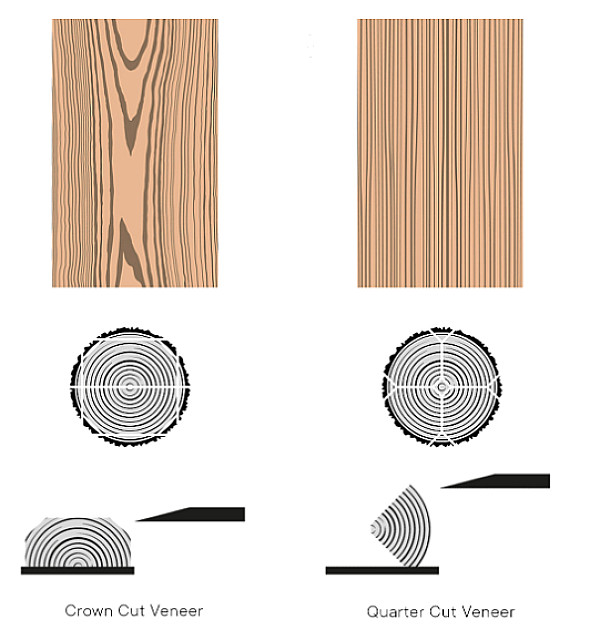See more blog articles
Cheat sheet- Crown Vs Quarter cut Oak
31 January 2025
Oak veneer is one of the most versatile materials in the woodworking industry, with different cutting techniques dramatically impacting the final appearance and characteristics of the wood surface. The two most widely available options are Crown cut, and Quarter cut Oak veneer.
The difference between Crown cut and Quarter cut Oak veneer
For Crown cut Oak veneer, the veneer is cut parallel to the tree's growth rings and produces a distinctive cathedral arch or flame-like grain pattern. You see a more varied and dramatic visual appearance and the natural character of the wood.
With Quarter cut Oak veneer, the veneer is cut perpendicular to the tree's growth rings which creates a straight, linear grain pattern. As a result of this, the veneer has a consistent, uniform appearance with minimal flake or figuring.

Which one to choose- Building the right aesthetic for your project
Crown cut
Produces a more traditional and classic aesthetic which is ideal for classic or rustic design styles. Natural woodgrain variations can be featured in your designs to create visual interest; however, you must consider that Crown cut Oak veneer can be less predictable in appearance. This can be challenging if you need to match grain over large surfaces, and there could potentially be more material wastage during production.
Quarter cut
Helps give a clean, modern aesthetic which fits well with contemporary design schemes. The predictable grain pattern of Quarter cut Oak maximises wood yield during production. Some customers think that Quarter cut Oak is less dramatic and not as natural looking than Crown cut.
Considerations
Budget- Quarter cut can sometimes be more economical if you do not have to consider grain matching areas of your project.
Project scale- larger areas benefit from Quarter cut's consistency, but Crown cut might be a better option if you want the scale of its naturalistic patterns.
Aesthetic preference- personal taste plays a crucial role- traditional vs contemporary.
We always recommend obtaining samples of both types of veneer before final selection. This helps you to consider lighting conditions in the intended space and to evaluate the samples under similar environmental conditions of the intended space.
Links to previous related blogs
Birch Plywood: A Versatile and Durable Material
Introducing Shinnoki by Decospan
Take aways/highlights
-
Choose Crown cut for traditional interior design.
-
Consider opting for Quarter cut for modern, architectural projects.
-
Always get a sample if you are struggling to choose.
Conclusion
Both Quarter cut and Crown cut Oak veneer offer unique advantages. The right choice depends on your specific design goals, aesthetic preferences, and practical requirements.
Written by Liz Cooke, Client Liaison Manager at CutList | January 2025

 LOGIN
LOGIN
